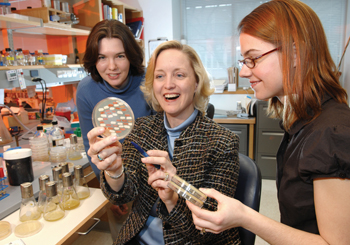
Susan Wente, Ph.D., center, in the lab with graduate student Laura Terry, left, and Elizabeth Tran, Ph.D. (photo by Neil Brake)
Study seeks keys to nuclear ‘doors’
The cell nucleus is something like a command center — secured within it are the DNA “plans” for cell function, and messengers enter and exit to carry out those plans.
Proteins, which are manufactured in the cell body, must move into the nucleus to perform various duties, including copying DNA into messenger RNA (transcription). Messenger RNAs must move out of the nucleus into the cell body to serve as templates for making proteins (translation).
“This elegant system of spatially separating transcription from translation allows for careful regulation of the genome,” said Susan Wente, Ph.D., professor and chair of Cell & Developmental Biology. “And it requires the machinery to selectively allow things to go in and out. Selective exchange of proteins and RNA between the nucleus and cytoplasm is absolutely essential for cell function.”
Wente and her colleagues have focused on the entry/exit machinery and how it ensures that the correct molecules are transported across the nuclear cell membrane.
The sites of transport, called “nuclear pore complexes,” are complicated structures composed of 30 different proteins present in at least eight copies each. Proteins and messenger RNAs (mRNAs) scheduled to move through the pore complex can be thought of as cargoes, complete with “zip code” signals that indicate their final destination in the cell, Wente explained. Specific receptors — “mail deliverers” — bind to the cargoes and move them through the nuclear pore complex.
In a pair of recent papers that build on a long line of their prior studies, Wente and colleagues report advances in understanding how mRNAs move through the nuclear pore complex and how they are released outside the nucleus.
Because various viruses, including HIV, “pirate” the cell's mRNA export pathways to move their own viral mRNAs out of the nucleus, understanding how normal messenger RNA export works could offer new ways to perturb viral function, Wente noted.
Laura Terry, a graduate student in Wente's group, examined pathways through the pore complex, which is lined by thousands of spaghetti-like strands called “FG filaments.” Exactly how these filaments work to facilitate cargo transport “is hotly debated,” Wente said.
“It was thought that these thousands of filaments were all redundant with each other and simply provided binding capacity for cargoes and their receptors,” Wente said.
Terry took advantage of a yeast model system to make combinations of mutations in various FG filaments. She was able to selectively disrupt mRNA export, but not protein import, and vice versa. She also mapped the precise pathway that the mRNA export receptor takes through the nuclear pore complex. The findings, reported in the Journal of Cell Biology, show that there are specific pathways through the pore that are dependent on select FG filaments, revealing new potential mechanisms for transport regulation.
The receptor and FG filaments alone are not sufficient for directional export of mRNA, however. Once an mRNA cargo makes its way through the pore, it needs to be released. A second set of studies led by postdoctoral fellow Elizabeth Tran, Ph.D., probed the requirements for release of mRNA into the cytoplasmic cell body. The investigators knew that an export-ready mRNA has certain proteins bound to it, and that it has different proteins bound when it is released. This suggested that mRNA-protein complexes undergo “remodeling” during export.
“Something happens at the pore complex that changes the proteins bound to the mRNA, and that is part of the directionality and release control,” Wente said.
The investigators speculated that a protein called Dbp5 played a role in remodeling the mRNA-protein complex so that mRNA could be released. They reported in Molecular Cell that activation of Dbp5 is required for the remodeling events and that specific RNA-binding proteins are selected for displacement.
Dbp5 is a member of a family of “DEAD-box” proteins — proteins that have a certain motif and are involved in every aspect of RNA physiology in the cell, Wente said.
“How those DEAD-box proteins are controlled and what their specific biochemical and biological activities are is really a wide open area. There have been very few characterized in vitro,” she noted.
The current work represents the first biochemical characterization of a DEAD-box protein with a physiological RNA-protein target.
Together, the reports from the Wente laboratory have defined two specific steps in the nuclear transport of mRNAs and opened opportunities for further characterization of the precise mechanisms controlling cellular transport events.
Yingna Zhou in the Wente group and collaborator Anita Corbett, Ph.D., at Emory University also participated in the studies reported in Molecular Cell. The research was supported by the National Institutes of Health.













